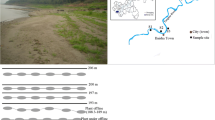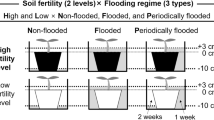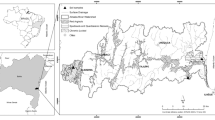Abstract
Naturally occurring floods in the summer months are the main source of surface water application in the foreland of Qira oasis, which is characterized by a hyperarid climate and is located at the southern fringe of the Taklimakan Desert. We investigated the impact of repeated artificial flood irrigation on seedling recruitment and growth of Alhagi sparsifolia and Karelinia caspica plant communities which are part of the dominant vegetation in Qira oasis. Flood irrigation was applied three times during the growing season and we studied the effect of irrigation on species recruitment, vegetation growth, species composition, and changes in soil water and nutrient concentrations in the soil profile. Results show that (1) repeated flood irrigation had a positive effect on seedling recruitment of the two species, with vegetative recruitment via root tillers being more important than seed recruitment for both species. (2) Irrigation promoted the germination and establishment of herbaceous weed species, which increased species diversity as well as ground coverage. (3) Irrigation also increased soil water and soil nutrient concentrations in the upper soil layer and changed the soil nutrients in the vertical profile. Available N, P, K and the total P and K increased in the soil profile. Our study demonstrates that naturally occurring flood irrigation has significant ecological benefits and plays an important role in promoting the renewal of desert vegetation and a short-term increase of soil nutrients. Our study also highlights the potential negative consequences for vegetation composition and rejuvenation if naturally occurring floods in the study area are diminished by either the effects of climate change or human management.
Similar content being viewed by others
References
Zhang X M, Michael R. Eco-physiology and Habitat Requirement of Perennial Plant Species in the Taklimakan Desert (in Chinese). Beijing: Science Press, 2006
Thomas F M, Arndt S K, Brelheide H, et al. Ecological basis for a sustainable management of the indigenous vegetation in a Central Asian desert: presentation and first results. J Appl Bot, 2000, 74: 212–219
Gries D, Zeng F, Foetzki A, et al. Growth and water relation of Tamarix ramosissima and Populus euphratica on Taklimakan Desert dunes in relation to depth to a permanent water table. Plant Cell Environ, 2003, 26: 725–736
Foetzki A. Water relations of perennial plant species of the hyper arid Taklamkan Desert. Diss Biol Fak, Univ. Göttingen, Göttingen, 2003. 256
Noy-Meir. Desert ecosystems, environment and producers. Ann Rev Ecol Syst, 1973, 4: 25–41
Gutierrez J R, Whitford W G. Chihuahuan Desert annuals: importance of water and nutrient. Ecology, 1987, 68: 409–418
Arndt S K, Kahmen A, Arampatsis C, et al. Importance of drought stress and nitrogen fixation in the desert legume Alhai sparsifolia results from 13C and 15 natural abundance studies in the field. In: Proceedings of the FAO/IAEA International Symposium on Nuclear Techniques in Integrated Plant Nutrient, Water and Soil Management, 16–20 October 2000, Vienna Austria, 2002. 406–407
Zhang H N. Regional integrated research model on oasis in south edge of Taklimakan Desert. Arid Region Study, 1995, 12(4): 1–9
Zeng F J, Foetzki A, Li X Y, et al. Water physiological indicators of Tamarix before and after irrigation in Qira oasis (in Chinese). J Appl Ecol, 2002, 13(7): 849–853
Zhang L Y, Mamati Anniwaer, Xia Y. Effect of irrigation on morphological features, community ecological structure and nature renewal of Alhagi sparsifolia in summer. Arid Region Study, 1995, 12(4): 34–40
Zhang L Y. Biological and ecological characteristics of Alhagi spacifolia. Plant, 2003, (1): 8–9
Li X Y, Zhang X M, He X Y, et al. Water characteristic of four perennial plants in Oasis-desert transition zone. Ecol J, 2004, 24(6): 1164–1171
Li Q. Development of floodwater irrigation (in Chinese). Chin Soil Water Conserv, 1996, (3): 36–37
Bruelheide H, Jandt U, Gries D, et al. Vegetation changes in a river oasis on the southern rim of the Taklamakan Desert in China between 1956 and 2000. Phytocoenologia, 2003, 33(4): 801–818
Xia X, Li C, Zhou X, et al. Desertification and Control of Blown Sand Disasters in Xinjiang (in Chinese). Beijing: Science Press, 1993
Yu Z J. Utilize floodwater irrigates desert to combat desertification. Chin Soil Water Conserv, 1994, (4): 5–7
Ling Y Q.Characteristics of the climate change in Taklimakan Desert. Chin Desert, 1990, 10(2): 9–19
Zhou X. Features of the deserts and changes in the desert surrounding in Xinjiang. In: Xia X, Li C, Zhou X, et al, eds. Desertification and Control of Blown Sand Disasters in Xinjiang (in Chinese). Beijing: Science Press, 1993. 1–63
Author information
Authors and Affiliations
Corresponding author
Additional information
Supported by National Natural Science Foundation of China (Grant No. 30670386) and Station Foundation of Chinese Academy of Sciences
About this article
Cite this article
Guo, H., Zeng, F., Arndt, S.K. et al. Influence of floodwater irrigation on vegetation composition and vegetation regeneration in a Taklimakan desert oasis. Chin. Sci. Bull. 53 (Suppl 2), 156–163 (2008). https://doi.org/10.1007/s11434-008-6018-z
Received:
Accepted:
Published:
Issue Date:
DOI: https://doi.org/10.1007/s11434-008-6018-z




